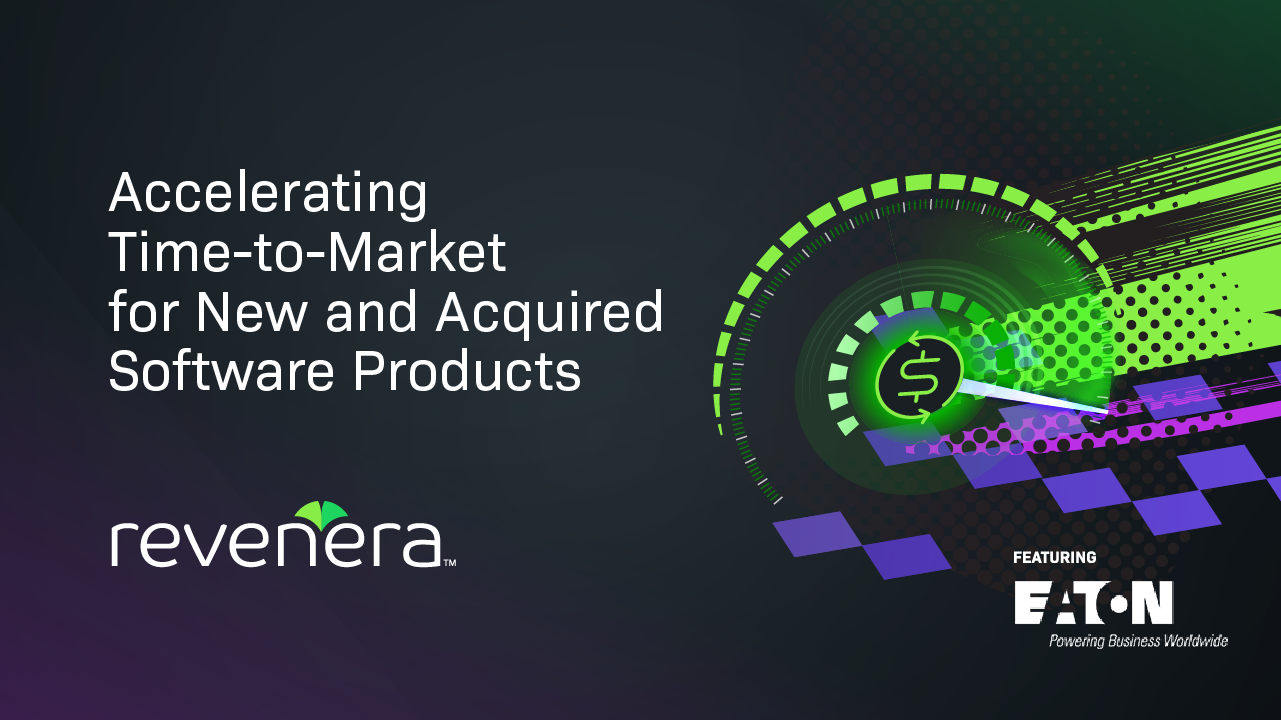Webinar
Accelerating Time-to-Market for New and Acquired Software Products
Discover how Eaton streamlined software delivery and licensing to reduce delays, boost customer experience, and drive recurring revenue.
Original Air Date: April 1, 2025
Overview
If you're a software producer looking to accelerate your time-to-market, this webinar is a must-watch. Join Eric Patalinghug, Product Manager at Eaton, as he shares how one of the world’s largest intelligent power management companies transformed its software delivery process. Hosted by Michael Goff from Revenera, the conversation dives into how Eaton tackled fragmented licensing systems, streamlined operations, and reduced delays in launching new software features.
You’ll hear firsthand how Eaton leveraged centralized entitlement management to improve customer experience and unlock new monetization models. Discover how their “paved roads” approach created repeatable patterns for faster product rollout, and how integrating licensing with ERP and CRM systems gave them deeper customer insights.
Whether you're in product management, engineering, or operations, you’ll walk away with actionable strategies to modernize your software business and scale efficiently. Don’t miss this opportunity to learn from a global enterprise that’s successfully navigating the shift from hardware to software.
Recap
Key Themes and Takeaways
Eaton’s Global Footprint and Software Evolution
The Challenge of Fragmented Licensing and Entitlement Systems
One of the major hurdles Eaton faced was the inconsistency in how different divisions handled licensing and entitlements. With multiple homegrown systems and processes, it was difficult to scale and maintain visibility across the organization. This fragmentation slowed down product launches and created inefficiencies in customer support and reporting.
Centralizing with Revenera to Accelerate Time-to-Market
To overcome these challenges, Eaton adopted Revenera as a centralized license and entitlement management platform. This move allowed them to standardize processes, reduce manual work, and create repeatable patterns—referred to internally as “paved roads”—for onboarding new products. As a result, Eaton significantly reduced the time required to commercialize new software releases.
Operational Transformation Over Technical Complexity
Interestingly, Eaton found that the biggest barrier to transformation wasn’t the technology itself, but the operational processes surrounding it. From order placement to ERP integration, aligning internal systems and teams was key to unlocking speed and efficiency. This insight underscores the importance of cross-functional collaboration in digital transformation efforts.
Enhancing Customer Experience Through Self-Service
By streamlining licensing workflows, Eaton improved the customer experience. Previously, customers had to call support to activate licenses. Now, they can self-service through an admin interface, applying keys instantly and getting up and running faster. This shift not only saves time but also reduces friction for end users.
Unlocking New Monetization Models
With a modern licensing infrastructure in place, Eaton is now exploring usage-based pricing and dynamic monetization. These models allow them to better align product value with customer outcomes, such as energy savings or uptime. The flexibility to test and deploy new models is a direct result of having centralized data and systems.
Building Visibility Across Divisions and Products
Revenera has enabled Eaton to unify customer data across divisions, giving them a clearer picture of product adoption and usage. This visibility helps customer success teams proactively engage with users, identify underutilized licenses, and improve onboarding. It also opens the door to bundling solutions in new ways, creating more cohesive offerings.
Advice for Organizations Starting Their Journey
Eric emphasized the importance of internal education and adoption. For large organizations, success depends on evangelizing the platform, aligning stakeholders, and building standard practices. Eaton’s “paved roads” approach has helped them scale more efficiently and avoid reinventing the wheel with each new product.
Speakers

Eric Patalinghug
Offer Manager, Commercial Infrastructure
Eaton

Michael Goff
Principal Product Marketer
Revenera
Frequently Asked Questions
Software companies can reduce time-to-market by streamlining their licensing and entitlement processes. Centralizing these systems eliminates manual steps and reduces delays in commercialization. By integrating licensing with ERP and CRM platforms, teams can automate workflows and improve operational efficiency. This allows engineering teams to focus on product innovation rather than backend logistics.
Centralizing licensing and entitlement management helps eliminate fragmented systems across product lines and business units. It improves visibility into customer usage, simplifies reporting, and enables faster onboarding of new products. A unified platform also supports scalability and reduces the risk of errors or inconsistencies in license delivery. Ultimately, it enhances both internal operations and customer experience.
Software monetization is a critical enabler of digital transformation, especially for companies shifting from hardware to software-based offerings. It allows businesses to explore new pricing models, such as usage-based or subscription licensing. Monetization platforms also provide insights into customer behavior, helping teams align product value with customer needs. This flexibility supports long-term growth and recurring revenue strategies.
Improving customer experience starts with making licensing seamless and self-service. Instead of requiring manual activation or support calls, modern systems allow customers to apply license keys instantly. This reduces friction and speeds up time-to-value. Additionally, centralized platforms can track adoption and usage, enabling proactive customer success outreach and better onboarding.
“Paved roads” refer to standardized, repeatable patterns for integrating licensing and entitlement management into new software products. These design patterns help teams avoid reinventing the wheel with each launch. By following proven workflows, companies can accelerate rollout, reduce errors, and ensure consistency across product lines. It’s a scalable approach to software delivery.
Usage-based licensing allows software providers to align pricing with the actual value delivered to customers. Instead of flat fees, customers pay based on consumption or performance metrics. This model can increase transparency and customer satisfaction while opening new revenue opportunities. It also encourages deeper engagement with the product, as customers see direct ROI from their usage.
Operational challenges often include aligning internal systems, standardizing processes, and educating teams on new workflows. Many delays stem not from technology limitations but from outdated manual procedures. Successful modernization requires cross-functional collaboration between product, engineering, sales, and support. Establishing clear processes and integrating systems is key to overcoming these hurdles
By integrating licensing platforms with ERP and CRM systems, software producers can track license activation, feature usage, and device adoption. This data helps identify underutilized products and informs customer success strategies. Visibility into adoption also supports upselling, renewal planning, and product roadmap decisions. It’s a powerful tool for driving engagement and retention.
Homegrown licensing systems can lead to inconsistent processes, scalability issues, and limited visibility across product lines. They often require manual intervention, which increases the risk of errors and delays. As companies grow, these systems become harder to maintain and integrate with other platforms. Moving to a centralized, commercial solution helps mitigate these risks and supports long-term growth.
Companies should consider changing their monetization model when customer needs evolve, new product types emerge, or existing pricing structures limit growth. Transitioning to models like usage-based or subscription licensing can better reflect product value and improve customer alignment. A flexible licensing infrastructure makes it easier to test and deploy new models without heavy engineering investment.
Resources
Case Study
a.i. solutions® Launch Flexible Licensing to Accelerate Growth
See how they saved two years in development time, reduced support tickets by 500%, and continue to grow.
Industry Report
Forrester Total Economic Impact Study
Learn More About 426% ROI and Operational Efficiencies Enabled by Revenera
Case Study
Toon Boom Drives Double-Digit Growth with Streamlined Monetization Processes
The implementation of the new licensing and entitlement management solution resulted in several tangible benefits for Toon Boom.
Want to learn more?
See how Revenera's Software Monetization platform can help you take products to market fast, unlock the value of your IP and accelerate revenue growth.
